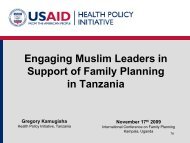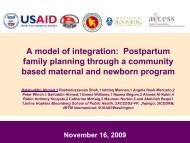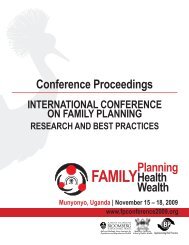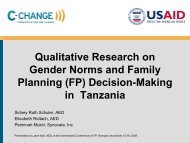structural roots of gbv and how it expresses itself through sexual
structural roots of gbv and how it expresses itself through sexual
structural roots of gbv and how it expresses itself through sexual
Create successful ePaper yourself
Turn your PDF publications into a flip-book with our unique Google optimized e-Paper software.
International Family Planning Conference<br />
Kampala, November 16-18, 2009<br />
Panel Gender <strong>and</strong> Reproductive Rights:<br />
The Foundations <strong>of</strong> Successful FP Programs<br />
EVIDENCE-BASED GUIDELINES FOR ADDRESSING ADOLESCENT<br />
CONTRACEPTION IN THE CONTEXT OF CONSERVATISM, POVERTY, AND<br />
GENDER-BASED VIOLENCE: A PERUVIAN STUDY<br />
Background<br />
María M. Raguz, PhD<br />
Pontificia Universidad Católica del Perú<br />
Lima, Peru<br />
Peru is chosen as one worse-scenario case for adolescent contraception for many<br />
reasons: It is one <strong>of</strong> the least gender-equ<strong>it</strong>able countries in the world; Latin America is<br />
the second region in the world in gender-violence <strong>and</strong> the WHO highlights the Peruvian<br />
real<strong>it</strong>y; <strong>and</strong> Peru is a clear example <strong>of</strong> the influence <strong>of</strong> conservative forces on social<br />
policies, as a national <strong>of</strong>ficial report to the Un<strong>it</strong>ed Nations recognizes, curtailing <strong>sexual</strong><br />
<strong>and</strong> reproductive rights <strong>and</strong> gender perspective. Hence, Peru has among the highest rates<br />
in the world <strong>of</strong> adolescent unwanted pregnancy; early pregnancy; <strong>and</strong> adolescent<br />
maternal mortal<strong>it</strong>y (FEM, 2005) -strongly linked to the estimated 100,000 annual<br />
illegal, cl<strong>and</strong>estine <strong>and</strong> unsafe abortions taking place. This is the case especially for<br />
adolescent girls in rural settings, in poverty <strong>and</strong> exclusion from education, health,<br />
communications <strong>and</strong> other basic services <strong>and</strong> development opportun<strong>it</strong>ies, as well as<br />
lacking c<strong>it</strong>izenship <strong>and</strong> the realization <strong>of</strong> human rights. Nevertheless, given the large<br />
inequ<strong>it</strong>ies w<strong>it</strong>hin Peru, <strong>it</strong>s national means only qualifies <strong>it</strong> as a medium-reproductive<br />
risk country, making these harsh real<strong>it</strong>ies invisible (Countdown 2015).<br />
Highl<strong>and</strong> Children <strong>and</strong> Young Mothers, Huaraz<br />
Cred<strong>it</strong>s: Maria Raguz<br />
Being a patriarchal society, Peruvian women are seen as vulnerable <strong>and</strong> needing<br />
protection but, also, the author<strong>it</strong>y <strong>of</strong> a man, <strong>and</strong> trad<strong>it</strong>ional gender ident<strong>it</strong>ies, roles,
stereotypes <strong>and</strong> power male to female relations prevail in the family, school, training<br />
<strong>and</strong> work environment, commun<strong>it</strong>y, health providers, <strong>and</strong> legal <strong>and</strong> judiciary system.<br />
This has led to Peru having among the worse Gender Development Indexes <strong>of</strong> the world<br />
(World Economic Forum, 2005) <strong>and</strong> being one <strong>of</strong> the two countries having all <strong>of</strong> the<br />
gender indicators under the world mean.<br />
Not only the country is patriarchal <strong>and</strong> sexist, but “Machismo” (“Macho” culture) is<br />
generalized. A 2008 survey carried by the Universidad de Lima s<strong>how</strong>ed 85% <strong>of</strong> Lima<br />
population believed Peruvian society to be sexist <strong>and</strong> that “Machism” prevailed.<br />
Women are considered <strong>of</strong> less value, males using force, violence, <strong>and</strong> other forms <strong>of</strong><br />
power to control female <strong>sexual</strong><strong>it</strong>y, reproduction, economy <strong>and</strong> lives, <strong>and</strong> evading <strong>sexual</strong><br />
<strong>and</strong> reproductive responsibil<strong>it</strong>ies, as a series <strong>of</strong> studies <strong>and</strong> publications attest. Peru has<br />
the worse economic gender gap in Latin America (UNIFEM 2003). In this context, a<br />
2009 Ombudsman <strong>of</strong>ficial report s<strong>how</strong>s a national mean <strong>of</strong> 42% <strong>of</strong> Peruvian urban<br />
women reporting being victims <strong>of</strong> physical violence by their intimate partner, ascending<br />
to 46% in the Amazon.<br />
In poor rural commun<strong>it</strong>ies men refer women “have to be kicked as a sack <strong>of</strong> potatoes so<br />
that they do not try to equalize w<strong>it</strong>h the husb<strong>and</strong>”, as found in a Population Council<br />
study we conducted some years ago.<br />
Peru is a highly diverse country in terms <strong>of</strong> race, ethnic groups, cultures, religions,<br />
geographic regions –Coastal Desert, Amazonian Jungle, <strong>and</strong> Andean Highl<strong>and</strong>s-,<br />
socioeconomic <strong>and</strong> urban development.<br />
Amazon IndigenousWoman<br />
Cred<strong>it</strong>s: Javier Silva<br />
Peru has among the highest w<strong>it</strong>hin-country socioeconomic gaps in the world, <strong>and</strong> half<br />
the population is poor, leading to adolescent girls living in extremely different real<strong>it</strong>ies<br />
w<strong>it</strong>h regard to their <strong>sexual</strong> <strong>and</strong> reproductive health, depending if they live in urban,<br />
semi-urban or rural settings <strong>and</strong> in the degree <strong>of</strong> poverty <strong>and</strong> marginalization.
Highl<strong>and</strong>s Girl Child<br />
Photo Cred<strong>it</strong>s: Maria Raguz<br />
NHS data s<strong>how</strong> adolescent pregnancy is more than threefold in the Amazon, <strong>and</strong> that<br />
78% <strong>of</strong> Cuzco pregnant adolescents claim they area having unwanted pregnancies.<br />
AMAZONAS<br />
26.5%<br />
CAJAMARCA<br />
18.7%<br />
TUMBES<br />
11.1%<br />
PIURA<br />
9.7%<br />
LAMBAYEQUE<br />
11.0%<br />
LA LIBERTAD<br />
9.6%<br />
ANCASH<br />
16.1%<br />
LIMA<br />
8.4%<br />
HUANCAVELICA<br />
24.9%<br />
AYACUCHO<br />
21.3%<br />
ICA<br />
8.8%<br />
PORCENTAJE DE ADOLESCENTES QUE<br />
ESTUVO ALGUNA VEZ EMBARAZADA<br />
PERU: 13.0% ENDES 2000<br />
AREQUIPA<br />
9.5%<br />
LORETO<br />
34.4%<br />
MOQUEGUA<br />
7.1%<br />
BRECHAS<br />
SAN MARTIN<br />
21.1%<br />
HUANUCO<br />
19.5%<br />
PASCO<br />
13.4%<br />
UCAYALI<br />
27.0%<br />
JUNIN<br />
10.4%<br />
MADRE DE DIOS<br />
23.6%<br />
CUSCO<br />
17.2%<br />
APURIMAC<br />
20.4%<br />
PUNO<br />
12.0%<br />
TACNA<br />
8.0%<br />
DiIGESA,<br />
MINSA<br />
2005<br />
Ministry <strong>of</strong> Health Map <strong>of</strong> Early Pregnancy Gaps in Peru 2005<br />
NHS s<strong>how</strong> only adolescent pregnancy <strong>and</strong> contraceptive use have not changed in the<br />
past decades, whereas young adults <strong>and</strong> adult women have lowered pregnancy <strong>and</strong><br />
fertil<strong>it</strong>y indicators <strong>and</strong> bettered contraceptive use. In 2006, 67% <strong>of</strong> <strong>sexual</strong>ly active<br />
adolescent women were pregnant, mostly, unwanted pregnancies. In Cuzco, 78% <strong>of</strong><br />
pregnant adolescents did not want that pregnancy.
Girls <strong>and</strong> boys grow in these gender-based violence environments <strong>and</strong> this affects the<br />
ways adolescent <strong>and</strong> young boys <strong>and</strong> girls, <strong>and</strong> also children, view <strong>sexual</strong><strong>it</strong>y, <strong>sexual</strong><br />
rights, <strong>sexual</strong> <strong>and</strong> reproductive health, <strong>and</strong> gender inequal<strong>it</strong>ies <strong>and</strong> violence, all <strong>of</strong> which<br />
are inextricably linked, <strong>and</strong> differential risks are derived, especially in the poorest<br />
populations. This has to be taken into account when designing Family Planning <strong>and</strong><br />
<strong>sexual</strong> <strong>and</strong> reproductive health policies, programs <strong>and</strong> interventions.<br />
Hypothesis<br />
Being female puts some adolescent girls in Peru at very specific high reproductive <strong>and</strong><br />
<strong>sexual</strong> risks given that discrimination against women combines w<strong>it</strong>h other social<br />
discriminations, such as age, race, ethnic<strong>it</strong>y <strong>and</strong> language, education, urban/rural<br />
cond<strong>it</strong>ion, poverty <strong>and</strong> other indicators <strong>of</strong> exclusion.<br />
Photo cred<strong>it</strong>s: Javier Silva<br />
Methodology<br />
This is a descriptive-comparative qual<strong>it</strong>ative study carried by the feminist NGO<br />
Movimiento Manuela Ramos, using semi-structured interviews, focus groups, <strong>and</strong> the<br />
technique <strong>of</strong> Commun<strong>it</strong>y Self-diagnosis developed <strong>and</strong> validated by this NGO <strong>through</strong><br />
decades <strong>of</strong> research. The Self Diagnosis is a qual<strong>it</strong>ative technique which entails<br />
drawings, life stories, trees <strong>of</strong> problems <strong>and</strong> solutions, consensual plenaries, <strong>and</strong><br />
workshops<br />
The study took place in populations where the NGO develops intervention projects.<br />
Incidental samples <strong>of</strong> 10-14 year old boys <strong>and</strong> girls, 15-19 year old adolescents, <strong>and</strong> 20-<br />
24 year old young adults living in rural <strong>and</strong> semi-urban poverty in the three distinctly<br />
different regions <strong>of</strong> Peru: Coast (Lima), Highl<strong>and</strong>s (Ayacucho), <strong>and</strong> Amazon (Ucayali<br />
Shipibo ethnic group). The study was the in<strong>it</strong>ial diagnostic part <strong>of</strong> a long-term<br />
intervention project in <strong>sexual</strong> <strong>and</strong> reproductive health <strong>and</strong> rights.
Ashaninka Ethnia in the Amazon, where<br />
girls are forced into marriage at age ten,<br />
W<strong>it</strong>h older men<br />
Data<br />
Qual<strong>it</strong>ative data was gathered by trained teams <strong>of</strong> researchers from 78 children, 40<br />
adolescents <strong>and</strong> 46 young adults. Through content analysis <strong>of</strong> the raw data, we<br />
identified underlying knowledge, att<strong>it</strong>udes, beliefs, values <strong>and</strong> behaviors w<strong>it</strong>h regard to<br />
<strong>sexual</strong><strong>it</strong>y, reproduction <strong>and</strong> gender, to gender-based violence <strong>and</strong> discrimination, <strong>and</strong> to<br />
<strong>sexual</strong> <strong>and</strong> reproductive health <strong>and</strong> rights. Social representations, fears, fantasies,<br />
dreams, emotions were also explored.<br />
Highl<strong>and</strong>s Young Mother in Huaraz<br />
Photo cred<strong>it</strong>s: Andrea De Romaña<br />
Although most topics to be explored were predetermined before the study was carried,<br />
new topics emerged in categorizing the verbal material. Topics covered included not<br />
only the usually covered ones in reproductive health studies: contraception, adolescent<br />
pregnancy, <strong>and</strong> abortion, but also addressed: gender ident<strong>it</strong>ies, homo<strong>sexual</strong><strong>it</strong>y,<br />
adolescent bodily changes, virgin<strong>it</strong>y, love, <strong>sexual</strong> relations, power issues, discrimination<br />
<strong>and</strong> violence. In this presentation special attention is paid to findings on contraception<br />
but other relevant content areas related to contraception are highlighted, <strong>and</strong> an attempt<br />
is made to explore the social <strong>roots</strong> <strong>and</strong> consequences <strong>of</strong> the findings.<br />
Comparisons are made between genders, age groups, <strong>and</strong> regions.
Lima Girl Child<br />
Photo cred<strong>it</strong>s: PUCP Psychology 50 Years<br />
Celebration Photo Contest<br />
Findings<br />
The major<strong>it</strong>y <strong>of</strong> female children, adolescents <strong>and</strong> young adults from poor settings in the<br />
three Peruvian regions studied evidence insufficient <strong>and</strong> inadequate knowledge<br />
concerning the body <strong>and</strong> reproduction, as well as the use <strong>of</strong> contraceptive methods. Not<br />
only knowledge is inadequate but they do manage information their commun<strong>it</strong>ies<br />
provide: non-scientific, not evidence-based information, but deeply engrained socially<br />
shared information, sometimes h<strong>and</strong>ed from generation to generation, about <strong>sexual</strong><strong>it</strong>y,<br />
gender, contraception <strong>and</strong> gender based violence. To this adds negative att<strong>it</strong>udes toward<br />
contraception –mainly, modern contraception- prevail, particularly w<strong>it</strong>h regard to <strong>it</strong>s<br />
use: Myths <strong>and</strong> exp<strong>and</strong>ed hearsay regarding supposed harms to health; moral sanctions<br />
to contraceptive use in young, unmarried people; <strong>and</strong> tolerance or resignation to<br />
extended gender violence in the everyday commun<strong>it</strong>y life. Even young adult women,<br />
including married women <strong>and</strong> mothers, s<strong>how</strong> poor knowledge, as they report their<br />
mothers had.<br />
Highl<strong>and</strong>s Mother <strong>and</strong> Child<br />
Photo cred<strong>it</strong>s: Maria Raguz
Poor knowledge <strong>and</strong> negative att<strong>it</strong>udes are embedded in cultures <strong>and</strong> societies where<br />
women are less valued, gender inequ<strong>it</strong>ies taint their everyday life <strong>and</strong> impact their<br />
<strong>sexual</strong> <strong>and</strong> reproductive health <strong>and</strong> their development. The study revealed females in<br />
general, but especially in the Amazon, feel they are less valued, lim<strong>it</strong>ed by their gender<br />
on what they can do, <strong>and</strong> subjected to mistreat, abuse, deception, ab<strong>and</strong>onment by their<br />
families <strong>and</strong> couples <strong>of</strong> themselves <strong>and</strong> their children, blame, even rape, <strong>and</strong> that their<br />
future is deterred by adolescent motherhood, “being unable to fulfill their educational<br />
<strong>and</strong> pr<strong>of</strong>essional goals <strong>and</strong> expectations <strong>and</strong> those <strong>of</strong> their parents”.<br />
Nevertheless, contraception is not an option, abstinence until marriage is the social<br />
m<strong>and</strong>ate. In this context, girls <strong>and</strong> young women are disempowered, can not actually<br />
become self-determined w<strong>it</strong>h regard to their <strong>sexual</strong><strong>it</strong>y <strong>and</strong> reproduction, including<br />
family planning.<br />
Lack <strong>of</strong> Scientific Information <strong>and</strong> Stone-Wr<strong>it</strong>ten Commun<strong>it</strong>y Information:<br />
It was not unusual to find young girls believing being “<strong>sexual</strong>ly active” implied no risk<br />
if one is very young, immature, their bodies are not ready yet for pregnancy even<br />
though menstruation was already present. They also believe discontinuous sex puts at<br />
no risk, or that pregnancy in the first intercourse is not possible.<br />
Highl<strong>and</strong>s Girl Child<br />
Photo Cred<strong>it</strong>s: Maria Raguz
Women <strong>of</strong> all ages, especially younger ones, associate fertil<strong>it</strong>y w<strong>it</strong>h blood<br />
(menstruation) <strong>and</strong> believe they are fertile during menstruation. Thus, <strong>it</strong> is not surprising<br />
that most unmarried young women in Peru use periodic abstinence –the rhythm method-<br />
<strong>and</strong> experience unwanted pregnancies, leading to unintended motherhood -78% <strong>of</strong><br />
adolescent mothers in Cuzco do not want the pregnancy they are carrying-, <strong>and</strong> this can<br />
lead to illegal cl<strong>and</strong>estine high-risk abortions, which strongly contribute to the high<br />
adolescent maternal mortal<strong>it</strong>y Peru has.<br />
Some women believe menstruation “cleans” the body from toxic residues, <strong>and</strong> modern<br />
contraception –e.g., injections- that affects bleeding is seen as a health risk, producing<br />
cancer. In general, modern contraception is associated w<strong>it</strong>h body harm. A young adult<br />
woman says contraceptive injection use leads to death because she knows “a woman<br />
whose blood stopped circulating well, her blood was ovulating in her lungs, <strong>and</strong> this<br />
killed her”.<br />
Adolescent Mother, Highl<strong>and</strong>s<br />
Photo cred<strong>it</strong>s: Maria Raguz<br />
Being able to name a contraceptive method is no guarantee <strong>of</strong> actually knowing about <strong>it</strong>.<br />
Although schoolgirls have had FP talks by medical personnel <strong>and</strong> heard on the matter in<br />
the radio or TV, girls s<strong>how</strong> confusion between the pill <strong>and</strong> emergency contraception,<br />
believing both to be abortion, or having wrong ideas about <strong>how</strong> to use them. For<br />
example, a Lima adolescent says “One takes one pill before or after sex, <strong>and</strong> another<br />
one 24 hours later… <strong>and</strong> the effect is they kill sperm <strong>and</strong> throw <strong>it</strong> out in the urine... Men<br />
can also take the pill.” Confusion also surrounds the IUD <strong>and</strong> female sterilization.<br />
A young adult woman says “the pill prevents the ovum from becoming mature.. what<br />
happens w<strong>it</strong>h the (menstruation) blood then? I don´t know where <strong>it</strong> goes.”<br />
Young males also share the misbelieves that contraceptives like the pill or injections kill<br />
unborn lives, <strong>and</strong> that injections can hurt the vagina which can get an infection <strong>and</strong> the<br />
woman dies, or that injections can become infected after some years. Young males also<br />
evidence poor knowledge <strong>of</strong> the body <strong>and</strong> <strong>it</strong>s processes, especially, the female´s body<br />
<strong>and</strong> the fertile cycle. Even natural herbs, believed to have contraceptive powers, are<br />
believed to be harmful for young girls because their bodies are not yet mature. This<br />
leads to preference for “natural” methods (mainly, rhythm, for condom reduces<br />
sensations).
Negative Att<strong>it</strong>udes: Beliefs, Values <strong>and</strong> Behaviors toward Contraception, but, also,<br />
toward Sexual<strong>it</strong>y in general<br />
Adolescent girls know <strong>of</strong> (i.e., are able to name) a variety <strong>of</strong> modern methods but<br />
strongly negative att<strong>it</strong>udes prevail concerning young people use <strong>of</strong> modern<br />
contraception. On the one side, there are moral <strong>and</strong> normative issues. One adolescent<br />
says that, in case <strong>of</strong> getting pregnant from her boyfriends their parents know nothing <strong>of</strong>,<br />
for they prohib<strong>it</strong> her any romance <strong>and</strong> dem<strong>and</strong> she wa<strong>it</strong>s until older for this, she would<br />
tell them pregnancy resulted from being raped by a stranger. This represents another<br />
reason why young girls prefer to use “natural” methods, for the pill or condoms can be<br />
found by their parents who try to control their <strong>sexual</strong><strong>it</strong>ies (more out <strong>of</strong> economic<br />
pragmatic reasons, such as the costs <strong>of</strong> early pregnancy for a poor girl <strong>and</strong> her family,<br />
than moral reasons). This illustrates <strong>how</strong> dramatic the s<strong>it</strong>uation is for a young girl <strong>and</strong><br />
<strong>how</strong> complicated <strong>it</strong> results for FP programs <strong>and</strong> interventions where society actually<br />
restrains <strong>sexual</strong> information, <strong>sexual</strong> education, health care services attending <strong>sexual</strong> <strong>and</strong><br />
reproductive needs, including access to counseling <strong>and</strong> to contraception.<br />
Highl<strong>and</strong>s Adolescents.<br />
Photo cred<strong>it</strong>: Maria Raguz<br />
Young people having sex are considered “unrestrained” <strong>and</strong> blamed for the<br />
consequences <strong>of</strong> their <strong>sexual</strong> <strong>and</strong> reproductive choices, but more so, women, being<br />
expected to control males, whose desire is believed to be stronger. Misinformation sets<br />
the ground for hearsay, which plays an important role in the prejudice against modern<br />
contraception in general. For example, anything “unnatural” -that is, manmade- is<br />
viewed as possibly harmful. Because <strong>of</strong> this they expect malformations in newborns if<br />
mothers have used contraception; they believe injections sterilize women <strong>and</strong> young<br />
girls believe injections <strong>and</strong> the pill “kill the baby”. This is the discourse <strong>of</strong> Catholic <strong>and</strong><br />
Evangelical forces which strongly influence poor, lowly-educated populations in Peru.<br />
More than lack <strong>of</strong> information, the issue entails personal <strong>and</strong> commun<strong>it</strong>y values,<br />
religious <strong>and</strong> moral beliefs, making <strong>it</strong> more difficult to address <strong>and</strong> change.<br />
A woman says the IUD is unsafe because “<strong>it</strong> can move during sex <strong>and</strong> pregnancy<br />
occurs <strong>and</strong> the Copper T is stuck in the baby´s body”…”It can also cause infection or<br />
cancer. And men say <strong>it</strong> bothers them during sex, they can feel <strong>it</strong>.” A third one says
“Pills are bad for the liver, they produce gastr<strong>it</strong>is, they can sterilize or produce Down<br />
Syndrome children; my sister was born w<strong>it</strong>h a blood mole in her face.”<br />
Another important issue is the strong conviction modern contraception fails: the pill, the<br />
condom, even injections, <strong>and</strong> DHS data prove this is so, due to inadequate method use.<br />
Hearsay is very strong on this <strong>and</strong> women in poverty generally distrust contraceptives.<br />
Only Reproductive Sex w<strong>it</strong>hin Marriage<br />
Adding to this, conservative moral, religious <strong>and</strong> even social <strong>and</strong> economic issues lead<br />
to valuing virgin<strong>it</strong>y <strong>and</strong> abstinence until marriage for young people <strong>and</strong>, especially,<br />
women, <strong>and</strong> this makes even having boyfriends being unacceptable, making modern<br />
contraceptive use “wrong”. Girls in poor settings refer they would prefer to tell their<br />
parents they became pregnancy due to rape than acknowledge having a boyfriend.<br />
Following Christian religious beliefs, women are expected to control male´s desire <strong>and</strong><br />
not tempt men; men are not held responsible for the consequences <strong>of</strong> their hetero<strong>sexual</strong><br />
<strong>and</strong> reproductive acts. Girls’ <strong>sexual</strong><strong>it</strong>y evidences more control <strong>and</strong> punishment (stigma,<br />
discrimination, <strong>and</strong> exclusion). Women are blamed for abortions, divorces,<br />
unfa<strong>it</strong>hfulness, even for rape.<br />
Cuzco church w<strong>it</strong>h religious motif: Hell for sinners.<br />
Photo cred<strong>it</strong>s: Maria Raguz<br />
Because <strong>of</strong> low acceptance <strong>of</strong> modern methods <strong>and</strong> permanent methods for young<br />
people, condom use, the most natural <strong>of</strong> the unnatural methods <strong>and</strong> the one easier to<br />
hide <strong>and</strong> also, available to buy on dem<strong>and</strong>, is the most accepted contraceptive method.<br />
Adolescent boys <strong>and</strong> girls in the study –especially in Lima- know <strong>how</strong> the basics <strong>of</strong> <strong>how</strong><br />
to use <strong>it</strong>, but males do not want to use <strong>it</strong> because “<strong>it</strong> does not feel the same”, <strong>and</strong> females<br />
feel disempowered to get them to use <strong>it</strong>, <strong>and</strong> fear being ab<strong>and</strong>oned or subjected to<br />
physical violence if they insist. Also, a girl is not expected to carry condoms w<strong>it</strong>h her,<br />
“being prepared” implying “promiscu<strong>it</strong>y”.<br />
Another issue is young people´s sex is mainly unplanned <strong>and</strong> thus, unprotected. To this<br />
<strong>it</strong> adds the difficult accessibil<strong>it</strong>y to modern contraception in poor <strong>and</strong> rural settings.<br />
Even if they are freely provided by public health services, access to these services is<br />
very lim<strong>it</strong>ed, as has been proven in studies about the delays to access health care in<br />
obstetric complications leading to maternal deaths. For young people this access is not<br />
only logistically complicated but social <strong>and</strong> cultural factors make <strong>it</strong> more difficult for<br />
them, <strong>and</strong> especially females, to look for <strong>sexual</strong> <strong>and</strong> reproductive health care. This is so
even in pregnant poor adolescents, who rarely have the minimum <strong>of</strong> three prenatal<br />
controls the Ministry <strong>of</strong> Health intends to provide to combat adolescent maternal<br />
mortal<strong>it</strong>y.<br />
Pregnant Adolescent<br />
learning to attend another<br />
adolescent’s baby at a<br />
Lima shelter. Photo cred<strong>it</strong>:<br />
María Raguz<br />
In Peru adolescents <strong>sexual</strong><strong>it</strong>y is actually being legally prohib<strong>it</strong>ed: a 2008 law considered<br />
rape any <strong>sexual</strong> activ<strong>it</strong>y w<strong>it</strong>h an adolescent or between adolescents, even among<br />
consenting adolescents or boy/girlfriend. This makes <strong>it</strong> more difficult for them to<br />
communicate on <strong>sexual</strong> <strong>and</strong> reproductive matters w<strong>it</strong>h pr<strong>of</strong>essors, health providers <strong>and</strong><br />
other adults, <strong>and</strong> w<strong>it</strong>h parents opposing their <strong>sexual</strong> activ<strong>it</strong>y, peers become their main<br />
source <strong>of</strong> (dis)information. This context is, evidently, not favorable for preventing<br />
reproductive risks.<br />
Not only sex outside marriage for youngsters is disapproved. Non-reproductive sex is<br />
disapproved for young people but for adults as well. Young adult women do not see<br />
matern<strong>it</strong>y as a free-choice but as a social m<strong>and</strong>ate, God’s or the Nature´s m<strong>and</strong>ate.<br />
Hence, they accept contraception only to space births <strong>and</strong> to stop having more children<br />
once they have enough, but not to postpone the first pregnancy or worse, to never<br />
become a mother.<br />
Male Gender Issues<br />
In poor settings, where gender roles <strong>and</strong> ident<strong>it</strong>ies <strong>and</strong> relations are clearly structured<br />
<strong>and</strong> defined, <strong>and</strong> male/female concepts are dichotomous <strong>and</strong> excluding, motherhood <strong>and</strong><br />
matern<strong>it</strong>y are female issues only, <strong>and</strong> there is almost no concept <strong>of</strong> shared responsibil<strong>it</strong>y<br />
concerning parenting or parenthood (there are no words in Spanish for these terms).<br />
Motherhood is a woman’s issue <strong>and</strong> her sole problem. Women are expected to control<br />
men´s desire <strong>and</strong> held responsible if they become pregnant, even in pregnancies<br />
resulting from rape. Machismo being now pervasive due to internal migration <strong>and</strong><br />
communication technologies, role complementation is less frequent than gender power<br />
relations <strong>and</strong> violence among poor populations. Women are devaluated <strong>and</strong> used as<br />
objects <strong>and</strong> men take no responsibil<strong>it</strong>y <strong>of</strong> their <strong>sexual</strong> <strong>and</strong> reproductive acts <strong>and</strong> society<br />
is pretty tolerant <strong>of</strong> economic, social, psychological <strong>and</strong> physical gender based violence.
Men in the study, from all regions, seem more aware <strong>of</strong> the need to use contraception<br />
because <strong>of</strong> poverty cond<strong>it</strong>ions <strong>and</strong> economic lim<strong>it</strong>ations, knowing families w<strong>it</strong>h seven or<br />
nine children <strong>and</strong> the problem they represent, probably because they feel they can be<br />
expected to provide for them. They highlight early pregnancies <strong>and</strong> their economic<br />
consequences can be prevented but put the burden on women.<br />
Highl<strong>and</strong>s family<br />
Photo cred<strong>it</strong>s: Maria Raguz<br />
Even young boys know <strong>of</strong> a variety <strong>of</strong> methods <strong>and</strong> are aware girls are worried <strong>of</strong><br />
becoming pregnant <strong>and</strong> use different methods, but they believe young girls should<br />
refrain from sex <strong>and</strong> only young adults –over age 18- should have access to free<br />
contraception. They also believe condoms are too big for young boys. They are more<br />
accepting <strong>of</strong> contraceptive use but always in married couples.<br />
Highl<strong>and</strong>s Children<br />
Photo cred<strong>it</strong>s: Maria Raguz<br />
Lima poor male adolescents’ use <strong>of</strong> contraception seems in confrontation w<strong>it</strong>h feelings<br />
<strong>of</strong> love <strong>and</strong> the sensation that magic is destroyed, lim<strong>it</strong>ing pleasure <strong>and</strong> introducing<br />
planning in something that should be spontaneous.
Lima Adolescent. Villa El Salvador.<br />
Photo cred<strong>it</strong>: Celia López<br />
Also Machismo plays a strong role: a girl being prepared for sex –i.e., having condoms-<br />
is socially disapproved, <strong>and</strong> many aggressive name-calling slang terms exist for her.<br />
Boys say the pill kills innocence, contraceptives turn you into a savage that doesn´t<br />
know what he is doing. To this <strong>it</strong> adds the value <strong>of</strong> exploring new things <strong>and</strong> <strong>of</strong> risky<br />
behavior, the exc<strong>it</strong>ement <strong>of</strong> knowing unprotected sex can be dangerous. Inconsistently,<br />
they prefer the abstinence method –saying no- to any other.<br />
Moral <strong>and</strong> religious issues also play an important part. Some adolescent boys in Lima<br />
believe using contraception kills love, for then <strong>it</strong> is only sex for pleasure. This could<br />
have to do w<strong>it</strong>h the idea that sex is, mainly for reproduction in the married, loving adult<br />
couple, a religious m<strong>and</strong>ate. They also expect young adult girls in love to surrender<br />
completely to their partners so they have children <strong>and</strong> become the mothers <strong>and</strong><br />
caregivers they expect them to be. Following religious precepts in the Peruvian<br />
conservative society, blame is usually placed mostly or solely on women. These Lima<br />
boys explic<strong>it</strong>ly view the unmarried woman as the responsible one for avoiding sex <strong>and</strong><br />
pregnancies; although males are blamed for seducing, females are blamed for accepting<br />
or not protecting themselves w<strong>it</strong>h natural methods. If a pregnancy occurs, the unborn<br />
innocent baby is to be defended.<br />
Photo Cred<strong>it</strong>: Justicia Juvenil<br />
Restaurativa<br />
Girls, ashamed to use modern contraceptives, expect boys to use <strong>it</strong>, but believe men to<br />
be electrical, sex-driven, <strong>and</strong> only wanting sex, <strong>and</strong> perceive them as coercive w<strong>it</strong>h girls<br />
<strong>and</strong> unwilling to use protection.
Sexual<strong>it</strong>y linked to Gender-Based Violence<br />
Unprotected sex <strong>of</strong>ten is linked to gender based violence, as these narratives attest:<br />
“He used no condoms. Worried he had made a son, he wanted her to have an<br />
abortion <strong>and</strong> the girl also wanted to, because she was studying <strong>and</strong> could not keep<br />
educating if she didn´t. When she was 3 months pregnant she self-induced an<br />
abortion, there in the street, w<strong>it</strong>h the root <strong>of</strong> the retama plant she drank.”<br />
Males <strong>of</strong> all ages <strong>and</strong> in the three regions believe females to be fools <strong>and</strong> fall prey to<br />
their enactment <strong>of</strong> love, <strong>and</strong> their promises. Young adult males use the argument<br />
nothing is going to happen to you, do not worry, I will come outside (w<strong>it</strong>hdrawal) or we<br />
can do <strong>it</strong> by the back door (anal sex), we insist we are experienced, we know <strong>how</strong>, no<br />
condom, we win! If there is a pregnancy, she can have an abortion if the man is not<br />
responsible enough. Machismo here becomes self-evident when males –the father, the<br />
<strong>sexual</strong> partner, the boyfriend- is usually the one w<strong>it</strong>h the final saying over the decision<br />
whether a young girl or even female adult should terminate a pregnancy or not. Males<br />
blame women for falling after the males’ enchanting discourse <strong>and</strong> for being fools <strong>and</strong><br />
believing their promises.<br />
“As soon as she falls in love w<strong>it</strong>h words, the girl ‘is done’, she´ll give in”.<br />
(Male adolescents from the Amazon <strong>and</strong> Highl<strong>and</strong>s)<br />
“(He) was a seducer; he starts having sex w<strong>it</strong>h another girl, he gets tired <strong>of</strong> the first<br />
one, doesn’t want her anymore. He ab<strong>and</strong>ons her, he is in love now w<strong>it</strong>h this other<br />
girl. Probably now he uses condoms w<strong>it</strong>h her, he shouldn´t have another children.”<br />
“At 15 years <strong>of</strong> age the Pomabamba adolescent works in the chicken store, in<br />
construction jobs, now he travels for holidays w<strong>it</strong>h his male friends to big c<strong>it</strong>ies:<br />
Lima, Ica, Huancayo, the Amazon, Chincha, Cusco… He learns to spend his life, –<br />
wiseguy- Sometimes one has a lot <strong>of</strong> girlfriends, sometimes one gets them pregnant.<br />
He inaugurates his cousins, sometimes he might respect a cousin, or fall for her,<br />
<strong>and</strong> fabricate children, like that, carelessly, when he is 13 or older, 15, 16 years, as<br />
is always the case.”<br />
“A man must have seven girlfriends, the girl, only one boyfriend, such is the law.<br />
When you are single you can mate w<strong>it</strong>h one <strong>and</strong> another <strong>and</strong> another; when you<br />
marry you can only have one woman.”<br />
(Male adolescents from the Amazon <strong>and</strong> Highl<strong>and</strong>s)
Lima Adolescent Mother<br />
Phot cred<strong>it</strong>s: Maria Raguz<br />
A boy cannot mistreat his woman -“su hembr<strong>it</strong>a” (Spanish slang)- unless she cheats<br />
on him, then yes. The girl makes the boy´s heart cry when she messes w<strong>it</strong>h someone<br />
else.”<br />
(Male Adolescent, Highl<strong>and</strong>s)<br />
“A boy, after he had sex w<strong>it</strong>h the girl for the first time, now he can dem<strong>and</strong> her:<br />
‘You are now my woman <strong>and</strong> I can h<strong>it</strong> you’. At first he acts lovingly but after having<br />
intercourse, not anymore.”<br />
(Female Adolescent, Lima).<br />
“Real” Love<br />
Most girls from these trad<strong>it</strong>ional <strong>and</strong> poor settings feel the need to live their <strong>sexual</strong><strong>it</strong>y<br />
tied to love. Although they share w<strong>it</strong>h boys that true love is w<strong>it</strong>hin marriage, they see<br />
their being in love in adolescence as real love <strong>and</strong>, maybe, <strong>it</strong> can become true,<br />
everlasting, inst<strong>it</strong>utionalized love, that is, marriage.<br />
“Sexual in<strong>it</strong>iation is not because <strong>of</strong> desire, <strong>it</strong> is because one has the illusion <strong>of</strong><br />
staying w<strong>it</strong>h the boy for all life. The boy does <strong>it</strong> because he wants to be w<strong>it</strong>h the girl,<br />
in his case <strong>it</strong> is only because <strong>of</strong> <strong>sexual</strong> desire.”<br />
“In older girls then <strong>it</strong> is because <strong>of</strong> <strong>sexual</strong> desire, same as men, but men have more<br />
desire <strong>and</strong> s<strong>how</strong> <strong>it</strong> more.”<br />
“Girls have the right not to be obligated to have sex, the right to be respected, to<br />
wa<strong>it</strong> until marriage. Sometimes the boy dem<strong>and</strong>s the pro<strong>of</strong> <strong>of</strong> love <strong>and</strong> says if the<br />
girls does not accept (having sex w<strong>it</strong>h him) she does not love him <strong>and</strong> that they have<br />
to break up. The girl falls <strong>and</strong> accepts.”<br />
(Female Adolescents, Lima)<br />
On the other h<strong>and</strong>, boys believe their <strong>sexual</strong> partners to be friends or girlfriends, <strong>and</strong><br />
acknowledge they can feel an “illusion” <strong>of</strong> love w<strong>it</strong>h them but “real love” is reserved to<br />
the woman they marry <strong>and</strong> have a family w<strong>it</strong>h, <strong>and</strong> not feel morally responsible for<br />
what happens to these other partners out <strong>of</strong> their mutual <strong>sexual</strong> activ<strong>it</strong>y.
Boys realize girls “in love” are more <strong>sexual</strong>ly accessible <strong>and</strong> explo<strong>it</strong> this:<br />
“It depends on her love that she gives her body to the boy. Women say: ‘I<br />
surrender to you because <strong>of</strong> love’, the more they love you the quicker you will<br />
get them. Not even a day, in a moment they fell for you.”<br />
(Adolescent Boys, Amazon)<br />
Girls are aware that when they fall in love “they don’t think anymore, they get carried<br />
away by their emotions, fantasies <strong>and</strong> desires, they have sex <strong>and</strong> do not protect<br />
themselves from pregnancies or AIDS.” When love is believed to be present, girls are<br />
torn between trusting the couple <strong>of</strong> not: if he will honor the respect she asks from him,<br />
if he will ab<strong>and</strong>on her or be there in case “anything happens” <strong>and</strong> fulfill the promises<br />
made.<br />
Love is perceived to lead girls <strong>and</strong> young women to do irrational things <strong>and</strong> to involve<br />
in risky behavior. Parents that find out their daughters –not sons- are romantically<br />
involved, prohib<strong>it</strong> this <strong>and</strong> punish <strong>it</strong>, many times, violently:<br />
“I had my sister <strong>and</strong> she was in love… She stopped doing home chores, <strong>and</strong> did<br />
everything for her boyfriend… she ran away <strong>through</strong> the window, I would tell<br />
mom <strong>and</strong> she would bring her home <strong>and</strong> batter her w<strong>it</strong>h a stick. The more he<br />
beat her, the more she escaped w<strong>it</strong>h the boy, the more rebellious she got.”<br />
(Boy from Lima)<br />
Boys <strong>and</strong> girls consider fools the girls that do not realize boys are not being truthful<br />
about their love feelings. Men cheat but women are the stupid ones that believe them.<br />
Males are justified from the belief their <strong>sexual</strong> drive is stronger <strong>and</strong> almost impossible<br />
to control, <strong>and</strong> even rape behavior is many times tolerated.<br />
Sacrifice<br />
Based upon the prevailing Catholic female model <strong>of</strong> Virgin Mary, women are expected<br />
to suffer <strong>and</strong> sacrifice for their families, <strong>and</strong> to tolerate infidel<strong>it</strong>y <strong>and</strong> even violence. In<br />
these patriarchal societies, males are believed to be the main providers –although more<br />
<strong>and</strong> more they are not- <strong>and</strong> working for a family is enough sacrifice, a much more<br />
valued sacrifice that the women´s.<br />
Women are seen <strong>and</strong> see themselves as sufferers, victims, mistreated, undervalued, not<br />
loved <strong>and</strong> at risk <strong>of</strong> violence <strong>and</strong> even rape, w<strong>it</strong>h a feeling <strong>of</strong> disempowerment <strong>and</strong><br />
impun<strong>it</strong>y when being violence targets, being ab<strong>and</strong>oned, abused, deceived, <strong>and</strong> in<br />
charge <strong>of</strong> children men do not undertake, flunking life <strong>and</strong> development expectations.<br />
Gender-based violence against women is <strong>structural</strong> in these sexist, patriarchal <strong>and</strong><br />
“macho” societies.
Internet picture. Anonymous.<br />
Violence in the couple is spread <strong>and</strong> hinders <strong>sexual</strong> <strong>and</strong> reproductive protection, as the<br />
following statements from Lima boys reveal:<br />
“He forces her to have sex, he throws her legs up to the shoulder, nicer if he ‘breaks<br />
her virgin<strong>it</strong>y’. If he ‘fabricates’ <strong>of</strong>fspring, he takes the fetus out even if she cries not to,<br />
that <strong>it</strong> is also her son.”<br />
“A wife has to be punched in the face”.<br />
“Women are battered for not allowing them to be f*, for not leaving the man take her<br />
panties down, for not leaving them f* them, or because they have been unfa<strong>it</strong>hful, or<br />
because they got pregnant.”<br />
(Adolescent boys, Lima <strong>and</strong> Highl<strong>and</strong>s)<br />
Semi-urban women in San Juan de Lurigancho, Lima,<br />
prepared this educational material for GV prevention
Rape is so widely extended, although no <strong>of</strong>ficial estimates exist, that rural girls say<br />
“Happiness is… not being raped”, especially by the father, stepfather, stepbrothers, or<br />
brothers, at their own home. They add: “When they touch us we become marked <strong>and</strong> we<br />
do not go out to play anymore, we are not the same anymore.” Adolescent girls say<br />
“Once you´ve been raped the other owns you, you are worthless”.<br />
Male adolescents <strong>and</strong> young adults refer they feel ent<strong>it</strong>led to force sex, or believe<br />
having sex w<strong>it</strong>h a drugged, drunk, unconscious woman is not rape; even in gang rape:<br />
“If she is not aware, is unconscious, <strong>it</strong> is not rape.”<br />
It must also be said that estimates s<strong>how</strong> also l<strong>it</strong>tle boys being raped, about half than<br />
girls: “L<strong>it</strong>tle boys are at risk <strong>of</strong> rape by drunk male adults, who fetch the kids. Blood<br />
comes out when they are raped <strong>and</strong> they become traumatized but the mother doesn´t<br />
want to accept the new husb<strong>and</strong> has raped them; she favors him, ‘flesh’ over the child,<br />
her own blood.” (Amazon Boys).<br />
Battered woman in Lima.<br />
Photo cred<strong>it</strong>s: Manuela Ramos<br />
This is not surprising when one realizes in some poor settings half or more young girls<br />
<strong>and</strong> adult women report having been <strong>sexual</strong>ly assaulted, as studies w<strong>it</strong>h small nonrepresentative<br />
samples s<strong>how</strong>.<br />
12-Year Old Mother, live-in maid raped<br />
by employer in Lima, <strong>and</strong> rejected from<br />
her family in the Highl<strong>and</strong>s, living in a<br />
State facil<strong>it</strong>y for Adolescent Mothers until<br />
her child is one year old., Villa El Salvador.
Photo cred<strong>it</strong>s: María Raguz<br />
Lessons Learned<br />
Peruvian girls living in poor, rural settings, having an indigenous origin, not being able<br />
to speak fluent Spanish, having poor schooling, <strong>and</strong> living in gender-violent contexts<br />
<strong>and</strong> conservative cultures, are in high <strong>sexual</strong> <strong>and</strong> reproductive health risks that national<br />
means <strong>and</strong> indicators do not necessarily reflect <strong>and</strong> that intervention programs <strong>and</strong><br />
public <strong>sexual</strong> <strong>and</strong> reproductive <strong>and</strong> family planning policies need to acknowledge.<br />
It becomes evident that when adolescent <strong>sexual</strong><strong>it</strong>y is denied, w<strong>it</strong>h a value-system<br />
promoting abstinence until marriage, modern contraception is seen as an adult-only <strong>and</strong><br />
w<strong>it</strong>hin-marriage-only issue; young girls refuse to use <strong>it</strong> for <strong>it</strong> would imply they are<br />
voluntarily having sex, when their parents consider adolescent sex unacceptable, <strong>and</strong><br />
even forbid them from having a boyfriend. Girls also expect boys to protect themselves,<br />
but they do not want to use condoms <strong>and</strong> feel less pleasure, <strong>and</strong> girls feel disempowered<br />
w<strong>it</strong>h regard to negotiating safe sex. Boys consider pregnancy a women´s issue <strong>and</strong> do<br />
not want to acknowledge their responsibil<strong>it</strong>y, even turning to ab<strong>and</strong>onment menaces <strong>and</strong><br />
dem<strong>and</strong>ing “love pro<strong>of</strong>s”, or resort o the use <strong>of</strong> physical violence, even rape. If any<br />
consequences derive from unprotected, even violent sex, women <strong>and</strong> girls are blamed<br />
<strong>and</strong> they carry the burden as well as the moral <strong>and</strong> social sanctions which end excluding<br />
them from development.<br />
Peruvian Highl<strong>and</strong>s woman wa<strong>it</strong>ing to<br />
give birth at a health center.<br />
Photo cred<strong>it</strong>s: Ministry if Health<br />
The intertwining <strong>of</strong> <strong>sexual</strong><strong>it</strong>y, gender, <strong>and</strong> violence issues needs to be addressed in<br />
Family Planning programs that intend to be effective <strong>and</strong> to really respond to the needs<br />
<strong>and</strong> contexts <strong>of</strong> young people <strong>and</strong> young adults living in poverty <strong>and</strong> gender-based<br />
violence, such as the ones participating in this Peruvian study.<br />
State, commun<strong>it</strong>y-based organizations, movements <strong>and</strong> NGOs must recognize the<br />
complex<strong>it</strong>y <strong>of</strong> <strong>sexual</strong><strong>it</strong>y <strong>and</strong> reproduction for young people living in poverty in<br />
conservative contexts. It implies adopting a cr<strong>it</strong>ical gender perspective, but also, <strong>sexual</strong><br />
rights, intercultural <strong>and</strong> human rights approaches. Interdisciplinary <strong>and</strong> multi-layered<br />
strategies have to be devised for dealing not only w<strong>it</strong>h young people but w<strong>it</strong>h the
contexts: family, school, commun<strong>it</strong>y, legal framework <strong>and</strong> social policies in which these<br />
youngsters are embedded, to foster a more pos<strong>it</strong>ive <strong>and</strong> rights-oriented view <strong>of</strong><br />
<strong>sexual</strong><strong>it</strong>y, reproduction <strong>and</strong> rights related to them. It is, in the end, a matter <strong>of</strong><br />
c<strong>it</strong>izenship.<br />
Young Highl<strong>and</strong>s Mother<br />
Photo Cred<strong>it</strong>: Maria Raguz<br />
After more than three decades working in the field –research, theory-building, programdesign,<br />
policy-design <strong>and</strong> advocacy, from the academy, NGOs, the Government <strong>and</strong><br />
international instances such as the UN, what I would like to convey <strong>through</strong> the<br />
presentation <strong>of</strong> these results as an example, is the complex<strong>it</strong>y <strong>and</strong> urgency <strong>of</strong> action in<br />
the field <strong>of</strong> family planning, reproductive health, gender <strong>and</strong> gender-based violence.<br />
Highl<strong>and</strong> mother <strong>and</strong> child.<br />
Photo cred<strong>it</strong>s: Maria Raguz
















